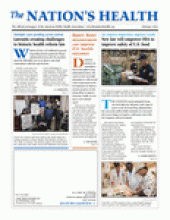Despite medical care expenditures that are the highest of any industrialized nation, deficiencies in the way health information is collected and a lack of agreement on the best indicators by which to measure progress are hindering efforts to improve Americans’ health, according to a new national report.
Released in December by the Institute of Medicine, the report calls on the nation’s health leaders to develop a core, standardized set of indicators to integrate and align health data and health outcome measurement at the national, state and local levels. According to the report, numerous health indicator sets developed in recent years and deployed in different contexts make assessment and comparison difficult for policy-makers and other decision-makers by highlighting similar information in different ways.
“There is a lot of work being done throughout the country at federal levels and at state and local levels to try to measure aspects of health,” APHA member Marthe Gold, MD, MPH, chair of the committee that wrote the report, told The Nation’s Health. “But it is not well coordinated and the discussions at the local level don’t necessarily reach well to the federal level and vice versa. So there is a real need to try to think about how we make our investments in measuring the factors that create health.”
The report committee’s vision of the factors that create health in populations — community-based factors and social and environmental determinants — is “very different” from the way the current U.S. health care delivery system is structured, said Gold, noting that the report calls on the U.S. Department of Health and Human Services to produce an annual report informing policy-makers, health leaders and the public about important trends and disparities in the social and environmental determinants that affect health.
“The public health community…shares a commonality of interests and insight as to what the true determinants of health are, and what this report tries to put into sharp relief is that we need to do a better job of measuring the variables that create and detract from health in this country, and that we need to move that measurement strategy away from traditional biomedical variables,” said Gold, who is a professor and chair of community health and social medicine at the Sophie Davis School of Biomedical Education at the City College of New York.
The report, “For the Public’s Health: The Role of Measurement in Action and Accountability,” also recommends that the United States adopt a single, summary measure of population health. Death rates have long been used as the standard measure of population health, the report said, but life expectancy by itself cannot capture information about the health-related quality of life associated with chronic illnesses and injuries. Summary measures of population health, such as health-adjusted life expectancy, capture an overall picture of the well-being of communities.
Moreover, the report recommends that HHS assign the National Center for Health Statistics a leadership role in a “renewed population-health information system” through better coordination and integration of the determinants of health. The report further recommends that the National Prevention, Health Promotion and Public Health Council — the federal body created as part of last year’s health reform law — update Congress annually on NCHS’ progress in assuming such a leadership role.
To ensure the public’s awareness of the quality, safety, efficiency and appropriateness of clinical care services delivered in their communities, the report calls on state and local public health agencies in each state to collaborate with clinical care delivery systems. Local performance reports about overuse, underuse and misuse should be made available for selected interventions, the report said, including preventive and diagnostic tests, procedures and treatment.
The report also recommends that HHS work with relevant federal, state and local public-sector and private-sector partners and stakeholders to develop a performance-measurement system that promotes accountability among governmental and private-sector organizations that have responsibilities for protecting and improving population health at local, state and national levels.
Authoring committee member Martin J. Sepulveda, MD, FACP, called the report a “wake-up call” to the health care delivery system, policy-makers, governmental public health leaders, employers and other payers.
“It tells policy-makers that you can control the ‘mix’ part of total cost by focusing on the medical care delivery system — namely the proportions of controlled versus complicated people with chronic diseases, but the avalanche of new people with chronic diseases will continue to flood the system and will keep total cost high,” Sepulveda, IBM fellow and vice president for integrated health services at IBM Corp. in Somers, N.Y., told The Nation’s Health.
The report also tells governmental public health that it needs to “think differently” about its role in the health crisis and forge new relationships with the health care delivery system to break down barriers and create and use shared pools of data to inform policy-makers and consumers about critical performance matters such as overuse, underuse and misuse of medical care, Sepulveda said.
“It needs to play a key role in helping people know where health care value lies and who is and isn’t delivering it in their communities,” Sepulveda said.
Sponsored by the Robert Wood Johnson Foundation, the report is the first of three on public health strategies to improve health. Reports examining public health and the law and public health and financing are due to be released within the next year.
For more information or to read the report, visit www.iom.edu/reports.
- Copyright The Nation’s Health, American Public Health Association












